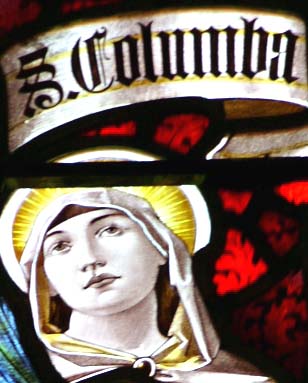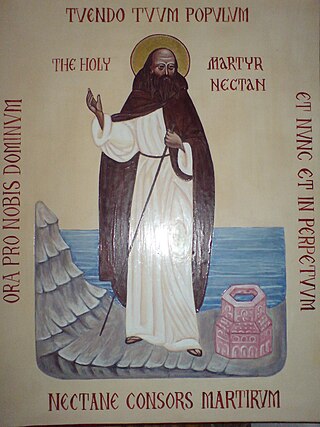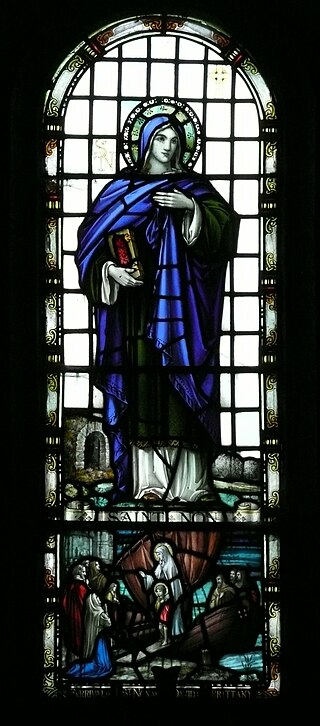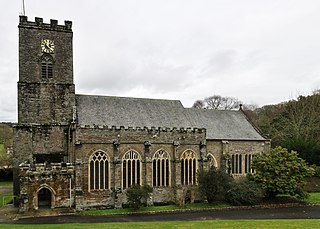
Piran or Pyran, died c. 480, was a 5th-century Cornish abbot and saint, possibly of Irish origin. He is the patron saint of tin-miners, and is also generally regarded as the patron saint of Cornwall, although Michael and Petroc also have some claim to this title.

Wenna was a medieval princess and Christian martyr who flourished in Wales and Cornwall. Later venerated as a saint, she is honored at multiple churches in Cornwall and Devon.
Salomon was a late 5th century Cornish 'warrior prince', possibly a King of Cornwall. His feast day takes place on the 18 October. He was the father of the Cornish bishop Saint Cybi.

Brychan Brycheiniog was a legendary 5th-century king of Brycheiniog in Mid Wales.

Keyne was a 5th-century holy woman and hermitess who was said to have travelled widely through what is now South Wales and Cornwall.

Morwenstow is a civil parish in north Cornwall, England, United Kingdom. The parish abuts the west coast, about six miles (10 km) north of Bude and within the Cornwall Area of Outstanding Natural Beauty (AONB).

Columba of Cornwall, also called Columb (English), was a saint from Cornwall who lived in the 6th century. She was born to pagan royalty, but became a Christian after the Holy Spirit, in the form of a dove, appeared to her in a vision. Her parents arranged a marriage to a pagan prince, but she refused the marriage and they imprisoned her. She escaped to Cornwall, where she was again captured and martyred. She is the patron of two churches in Cornwall, in St Columb Major and St Columb Minor, where well-developed traditions arose about her. The traditions include a tale about a spring gushing forth along the path of her blood at the site of her execution and another about a well at the site containing water that would not boil. Various dates in November have been cited as her feast day.

Marhamchurch is a civil parish and village in north Cornwall, England, United Kingdom.

Saint Nectan, sometimes styled Saint Nectan of Hartland, was a 5th-century holy man who lived in Stoke, Hartland, in the nowadays English, and at the time Brythonic-speaking, county of Devon, where the prominent St Nectan's Church, Hartland is dedicated to him.

Mabyn, also known as Mabena, Mabon, etc., was a medieval Cornish saint. According to local Cornish tradition she was one of the many children of Brychan, king of Brycheiniog in Wales in the 5th century. The village and civil parish of St Mabyn is named for her, and the local St Mabyn Parish Church is dedicated to her.

Ia of Cornwall was an evangelist and martyr of the 5th or 6th centuries, flourishing in the area of St Ives, Cornwall. She is said to have been an Irish princess, the sister of Erc of Slane.
Trethevy is a hamlet in north Cornwall, England, United Kingdom.

Non was, according to Christian tradition, the mother of Saint David, the patron saint of Wales.

The Church of St Morwenna and St John the Baptist is the parish church of Morwenstow, north Cornwall, England, United Kingdom, the most northerly parish in Cornwall. The church is dedicated to Morwenna, a local saint, and to John the Baptist, and is recorded in the National Heritage List for England as a designated Grade I listed building. It is an active Anglican parish church in the diocese of Truro, the archdeaconry of Bodmin, and the deanery of Stratton. Its benefice is combined with that of St James, Kilkhampton to form the United Benefice of Kilkhampton with Morwenstow.

St Mabyn Church is a Grade I listed late 15th-century Church of England parish church in St Mabyn, Cornwall, United Kingdom. The church is dedicated to Saint Mabyn or Mabena, who was regarded in local tradition as one of the many children of Brychan, a Welsh saint and King of Brycheiniog in the 5th century.

Christianity in Cornwall began in the 4th or 5th century AD when Western Christianity was introduced as in the rest of Roman Britain. Over time it became the official religion, superseding previous Celtic and Roman practices. Early Christianity in Cornwall was spread largely by the saints, including Saint Piran, the patron of the county. Cornwall, like other parts of Britain, is sometimes associated with the distinct collection of practices known as Celtic Christianity but was always in communion with the wider Catholic Church. The Cornish saints are commemorated in legends, churches and placenames.

Saint Enodoc, originally Wenedoc, was a sub-Roman Pre-congregational saint of Cornwall.
Adwen or Adwenna was a 5th-century Christian virgin and saint. She is recorded as a daughter of Brychan, king of Brycheiniog in south Wales, in the Cornish Life of Saint Nectan and in Robert Hunt's collection of Cornish legends. These sources associate her with the establishment of the parish of Advent in Cornwall.

Tetha, also known as Teath, Tecla, and by a variety of other names, was a 5th-century virgin and saint in Wales and Cornwall. She is associated with the parish church of St Teath in Cornwall. Baring-Gould gives her feast day as 27 October, but this has been called a mistaken conflation with Saint Ia. In 1878, it was held on the movable feast of Whit Tuesday. Other sources place it on 1 May, 6 September, and (mistakenly) 15 January. It is no longer observed by either the Anglican or Catholic church in Wales.














